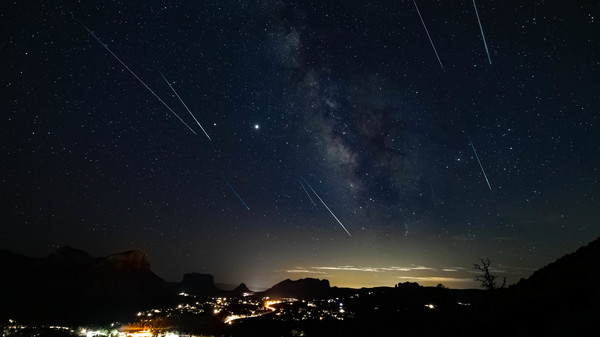Don’t Miss the Perseids 2023
This year, the Perseid Meteor Shower peaks on a weekend, and—with an almost New Moon—we are in for a spectacular show.


The Perseid Meteor Shower is one of the brighter meteor showers of the year—the Perseids over Sedona, Arizona, United States.
©iStockphoto.com/Diane Kulpinski
The Perfect Weekend Show
The Perseids peak around the night of Saturday, August 12, and into the early hours of Sunday, August 13.
And with the Moon shrinking to an invisible Micro New Moon on August 16, the night sky will be ideally dark to catch the whole spectacle of up to 100 shooting stars per hour.
From around mid-July, you can start seeing some sporadic shooting stars, which can last toward the end of August.
Your best time to see the Perseids
Find a Dark Viewing Spot
Any stargazer would tell you that darkness and patience are the keys to seeing shooting stars. Find a place with little light pollution, and get comfortable.
Dress for the weather, bring something to lie on, like a blanket, and then wait. Your eyes need to adjust to the darkness, and it can take up to 20 minutes, so put away your phone.


The Perseid Meteor Shower radiant in our Interactive Meteor Shower Map. Meteor showers appear to originate from the radiant, but meteors can appear in any part of the sky.
©timeanddate.com
Look for Cassiopeia and Perseus
Once outside, look toward the radiant, in the Perseus constellation—the Perseids are named after it because the meteors seem to radiate from that area in the sky. However, it might be better to look for Cassiopeia—the constellation looks a bit like a W or an M—as it might be a bit easier to recognize in the sky.
In the Northern Hemisphere, the radiant rises throughout the night, reaching its highest point in the sky at dawn. This means the shower is often better in the hours after midnight. Even though the meteors come from the radiant, they can appear in any part of the night sky.
Jupiter and Saturn Are Up Too
And while you’re out: Find Jupiter and Saturn in the eastern and southern sky.
Both can easily be spotted with the naked eye and look like big, bright ‘stars.’ The way to recognize planets from stars is that they shine steadily and don’t twinkle like stars.